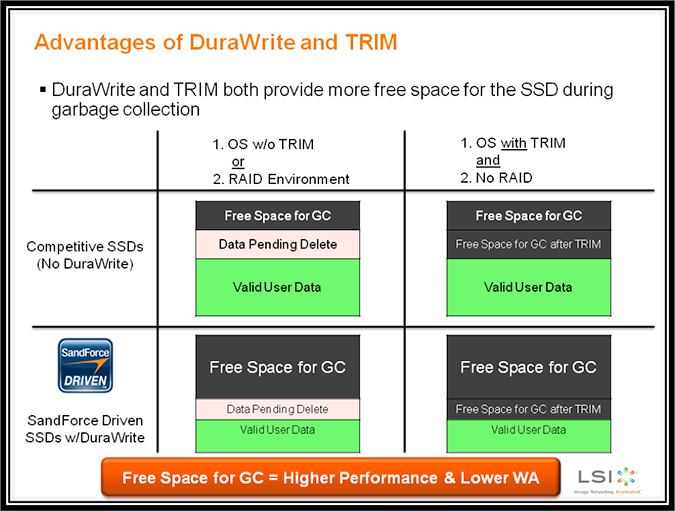Imagine a bathtub full of water and asking someone to empty the tub while you turn your back for a moment. When you look again and see the water is gone, do you just assume someone pulled the drain plug?
I think most people would, but what about the other methods of removing the water like with a siphon, or using buckets to bail out the water? In a typical bathroom you are not likely to see these other methods used, but that does not mean they do not exist. The point is that just because you see a certain result does not necessarily mean the obvious solution was used.
I see a lot of confusion in forum posts from SandForce Driven SSD users and reviewers over how the LSI DuraWrite data reduction and advanced garbage collection technology relates to the SATA TRIM command. In my earlier blog on TRIM I covered this topic in great detail, but in simple terms the operating system uses the TRIM command to inform an SSD what information is outdated and invalid. Without the TRIM command the SSD assumes all of the user capacity is valid data. I explained in my blog Gassing up your SSD that creating more free space through over provisioning or using less of the total capacity enables the SSD to operate more efficiently by reducing the write amplification, which leads to increased performance and flash memory endurance. So without TRIM the SSD operates at its lowest level of efficiency for a particular level of over provisioning.
Will you drown in invalid data without TRIM?
TRIM is a way to increase the free space on an SSD — what we call dynamic over provisioning — and DuraWrite technology is another method to increase the free space. Since DuraWrite technology is dependent upon the entropy (randomness) of the data, some users will get more free space than others depending on what data they store. Since the technology works on the basis of the aggregate of all data stored, boot SSDs with operating systems can still achieve some level of dynamic over provisioning even when all other files are at the highest entropy, e.g., encrypted or compressed files.
With an older operating system or in an environment that does not support TRIM (most RAID configurations), DuraWrite technology can provide enough free space to offer the same benefits as having TRIM fully operational. In cases where both TRIM and DuraWrite technology are operating, the combined result may not be as noticeable as when they’re working independently since there are diminishing returns when the free space grows to greater than half of the SSD storage capacity.

So the next time you fill your bathtub, think about all the ways you can get the water out of the tub without using the drain. That will help you remember that both TRIM and DuraWrite technology can improve SSD performance using different approaches to the same problem. If that analogy does not work for you, consider the different ways to produce a furless feline, and think about what opening graphic image I might have used for a more jolting effect. Although in that case you might not have seen this blog since that image would likely have gotten us banned from Google safe for work searches.
I presented on this topic in detail at the Flash Memory Summit in 2011. You can read it in full here: FMS 2011 Garbage Collection – Kent Smith








Leave A Comment